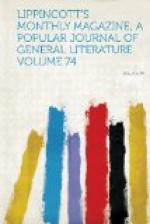What Europe did send to New York sufficed to prove the superiority of our own artisans in such labor-saving contrivances as suited the conditions of the country. The foreign implements and machines were more cumbrous in both complexity and weight of parts than ours. In the finer departments of manufacture, the Gobelin tapestry, the French glass, porcelain and silks, the broadcloths of England and Prussia, and a host of other such articles, could expect no rivalry here. The slender contributions of statuary and paintings hardly sufficed to illustrate the conceded superiority of the Old World in art. Crawford and Powers did very well by the side of the other, disciples of the antique, their chief opposition coming from some indifferent plaster-casts of Thorwaldsen’s Twelve Apostles. In point of popularity, Kiss’s spirited melodramatic group of the Amazon and Tiger threw them all into the shade. Its triumph at London was almost as marked, and the innumerable reductions of it met with everywhere show it to be one of the few hits of modern sculpture.
The general result of the exhibition was to encourage our manufacturers, without giving them a great deal of food for higher ambition; while our artists and the taste of their patrons, actual and possible, were disappointed of the instruction they had reason to expect, and which the ateliers of Europe will supply in fuller measure this year.
The succeeding years present us with an epidemic of expositions, most of them, often on the slenderest grounds, arrogating the title of “international.” The sprightly little city of Cork was one year ahead of New York. Then came Dublin in ’53, Munich in ’54, Paris in ’55, Manchester in ’57 (of art exclusively, and very brilliant), Florence in ’61, London again in ’62, Amsterdam in ’64; and in ’65 the mania had overspread the globe, that year witnessing exhibitions dubbed “international” in Dublin, New Zealand, Oporto, Cologne and Stettin, with perhaps some outliers we have missed. Then ensued a lull or a mitigation till the moribund empire of France and the remodeled empire of Austro-Hungary flared up into the magnificent demonstrations of ’67 and ’73. To these last we shall devote the remainder of this article, with but a glance at the second British of 1862.
[Illustration: MANCHESTER EXHIBITION BUILDING, 1857.]
This, held upon the same ground with its forerunner of eleven years previous, affords a better measure of progress. It developed a manifest advance in designs for ornamental manufactures. The schools of decorative art were beginning to tell. Carpets, hangings, furniture, stuffs for wear, encaustic tiles, etc. showed a sounder taste; and this in the foreign as well as the British stalls. French porcelain was more fully represented than before, and in finer designs. The Paris exhibition of ’55, more extensively planned, though less of a financial success, than the London one it followed, was not without effect on the industry and art-culture of France. The United States also showed that they had not been idle. Our fabrics of vulcanized rubber and sewing-machines were boons to Europe she has not been slow to seize. The latter are now sold in England, with trifling modifications and new trademarks, at from one-third to one-half the price our people have to pay.




